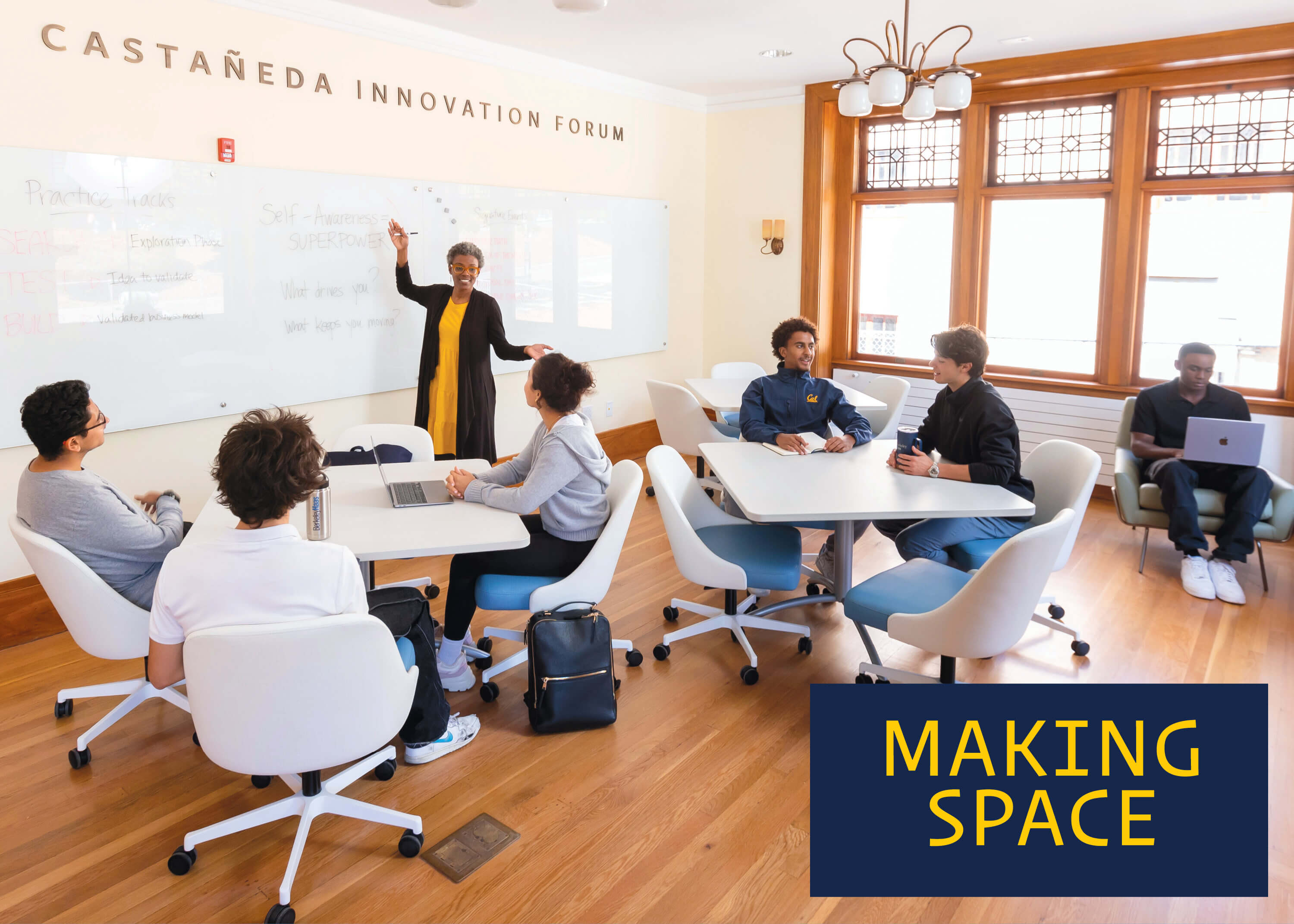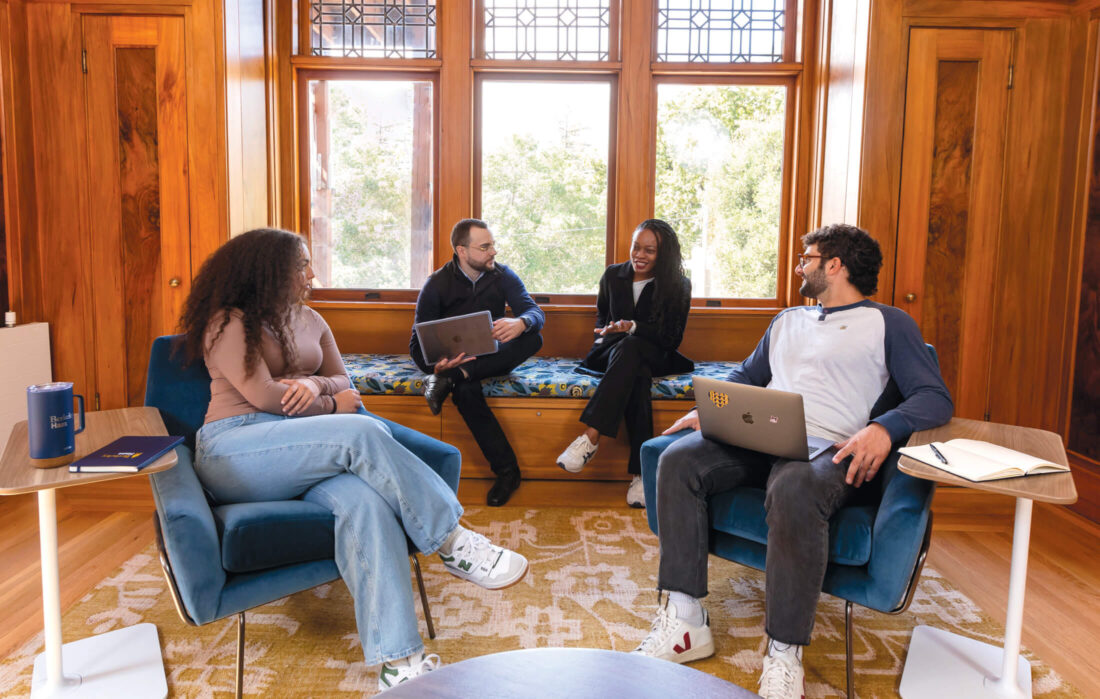Beyond Yourself, Entrepreneurship Edition
Haas entrepreneurship thrives because of our strong community. Here are just some ways alumni can help.
Haas News
Table of Contents
New eHub enhances robust innovation and entrepreneurship offerings at Haas.

Haas and Berkeley have long been breeding grounds for entrepreneurs, and PitchBook rankings published earlier this year prove it. UC Berkeley ranked the top university in the world for the number of undergraduate alumni founders and the number of venture-backed companies founded by undergraduate alumni over the past 10 years. Women founders also topped the list, ranking first in number of founders, number of venture-backed startups, and capital raised. Among MBA startups, Haas was in the top 10, with 482 companies and $17.5 billion in capital raised. Meanwhile, a new study by Stanford’s Venture Capital Initiative revealed that Haas has 2.8 founders of U.S. unicorns (companies with a billion-dollar valuation) per 1,000 full-time MBA graduates—that’s almost one in every class!
Some of the most successful companies arise when founders from different disciplines partner in productive ways to tackle society’s biggest challenges. In Poets & Quants’ 2024 list of the 100 highest-funded MBA startups, the seven Haas companies making the list—including transportation company Kyte, payment infrastructure company AtoB, and therapeutic company Catena Bioscience—feature co-founders skilled in business but also engineering, technology, and biotechnology.

Now, students across Berkeley have a new home to find one another: The Entrepreneurship Hub (eHub) at Haas provides space and programming to help entrepreneurs and those curious about it to connect, build, and be discovered. The eHub also serves as a gateway, helping students navigate UC Berkeley’s scores of innovation opportunities by crafting personalized pathways for them.
It’s one part of a dynamic ecosystem, which also includes a robust curriculum, world-class accelerator, and groundbreaking faculty research that Haas has developed to bring society-changing ideas to life.
Haas’ new eHub was designed to simplify navigating the vast array of innovation resources on campus and to provide easy access to support and mentorship. Programming has already begun, while the new space, located on Piedmont Avenue in a historic Julia Morgan building adjacent to Haas, is slated to open this winter. The eHub serves as an entry point, a gathering place, an incubator, and a launching pad, demystifying entrepreneurship and making it more accessible for all Berkeley undergraduate and graduate students, whether they’re already passionate about starting a company or simply curious about the idea—what eHub Faculty Director Saikat Chaudhuri refers to as “entrepre-curious.”
“We have a special focus on the entrepre-curious, because we need to lower the barriers for doing great things,” Chaudhuri says.
The eHub’s renovated three-story building includes meeting areas and workspaces to host a wide range of programming. A series of signature events provides opportunities to learn, practice entrepreneurship, and socialize. For students ready for something more extensive, there are three semester-long practice tracks—SEARCH, TEST, and BUILD—to engage them more deeply.
The SEARCH track is designed for students who don’t yet have an idea to work on, says Dawn McGee, the eHub’s executive director, who curated and designed its activities. “Students search for a problem worth solving. Something that’s meaningful enough to them that it motivates them to do the work that’s required of an entrepreneur,” she says. Once they’ve selected a problem they care about, they engage in brainstorming sessions to find solutions exciting enough to motivate testing.
Students who already have ideas can join the TEST track, where they gather a body of evidence about their venture’s desirability, feasibility, and viability.
The BUILD track, for students with evidence to support building their business model, offers hacking sessions with other participants to move through tasks that are hard to get done. BUILD students are also matched with a mentor who provides advice and support, and, says McGee, holds mentees accountable to their goals over the course of the semester.
In addition to Chaudhuri and McGee, the third key player at the eHub is Navigator Karenna Rehorn. Rehorn talks to students about their interests and determines next steps. “Many students simply need a pathway highlighted to get started pursuing what they’re interested in,” Rehorn says.
Students are often surprised to learn that the navigator is an actual person, rather than AI. But Rehorn is indeed real, and they’re committed to helping students understand the many resources available to them.
“The advising piece plus the eHub practice opportunities open doors for students to explore entrepreneurship in a way that is not currently available on the Berkeley campus,” Rehorn says.
Before Rhonda Shrader, MBA 96, became the executive director of the Berkeley Haas Entrepreneurship Program (BHEP), she founded several companies. As exhilarating as that may have been, she says teaching at Haas is truly her sweet spot. “I found my passion helping students and early-stage founders do it better than I did,” she says.
Doing it better entails using a different methodology from the one Shrader learned when she was getting her MBA. “We don’t do business plans anymore because those become obsolete the second you step out the door,” she says. Instead, Shrader and her co-faculty teach the Lean LaunchPad method, pioneered by Steve Blank at Haas in 2011. Shrader likens the method to teaching students to fish rather than simply giving them a platter of sushi. Courses like Lean Transfer provide a set of tools and skills to help students nail down a viable product/market fit. Keys to the approach are talking to people outside the classroom, testing out hypotheses, and incorporating feedback. “It’s really about applying the scientific method to business,” Shrader says.
In addition to coursework, BHEP oversees several experiential offerings that support students and early founders as they advance their ventures. These include Berkeley StEP, a 10-week pre-accelerator that’s run by Haas alumni; the U.S. National Science Foundation I-Corps, which helps to commercialize technology from students and faculty across campus; and UC LAUNCH, a UC-wide startup accelerator that guides ventures from prototype to pitch.
“We have a special focus on the entrepre-curious, because we need to lower the barriers for doing great things.”
—Saikat Chaudhuri
eHub Faculty Director
The results speak for themselves. As noted above, seven teams from Haas made this year’s Poets&Quants list of the top 100 MBA startups, which tracks current MBA students and alumni up to five years out, and last year’s list had nine Haas teams. Ten years ago, before the Lean method began bearing fruit, the number of Haas teams on the list was zero.

The methodology isn’t the only thing that’s changed at Haas for budding entrepreneurs. Today’s future founders are tackling a different set of problems, many of which are challenges created by new technology. Just one example: Ghazaleh Sadooghi, MBA 25, and Mo Zadeh, MIMS 16 (Berkeley’s School of Information), co-founders of Rumi Technologies, are solving the problem of AI policy enforcement in classrooms (see p. 14). The startup won last year’s UC LAUNCH accelerator. Shrader says that Haas students are “increasingly focused on solving urgent problems with huge impact.”
Another central player in Berkeley’s entrepreneurship offerings is Berkeley SkyDeck, a startup accelerator that was formed in 2012 as a partnership between Haas, the College of Engineering, and the Office of the Vice Chancellor for Research. Since 2014, it has been led by Caroline Winnett, MBA 90, who this year was named to the Forbes 50 over 50 list for her influential work there.
Twice yearly, some 20 startups are selected for SkyDeck’s intensive, six-month program to prepare them to raise their first round of investment from Silicon Valley venture capitalists. Cohorts have access to 700 advisers and an alumni network that’s 500,000 members strong.

Each of the companies receives $200,000—an amount that’s doubled in the past few years—which comes from the SkyDeck Fund, a dedicated partner that invests in the startups and gives 50% of its profits back to the university in a unique public-private partnership. “No other university does this that we’re aware of,” Winnett says. “We’re looking for the next Tesla, Apple, Google, and when those startups emerge and exit, get acquired, or go public, we’re just imagining how powerful that funding will be to support education.”
Until recently, SkyDeck limited applications to companies affiliated with Berkley or international startups. But Winnett says that’s no longer the case. Today, any startup is free to apply, although Berkeley alumni and faculty are given priority.
While the accelerator selects more mature startups that are ready to attract VC funders, SkyDeck’s four-month incubator program, Pad-13, works with early-stage ventures focused on growing and preparing themselves to apply to the accelerator program.
SkyDeck also works extensively throughout the international entrepreneurship ecosystem to empower startups and founders worldwide. For example, SkyDeck and JETRO, a branch of the Japanese government, have a meaningful partnership to support founders from Japan to grow their startups. In 2021, SkyDeck launched a Milan-based program, helping founders focused on getting traction and fundraising in Europe.
We often think of entrepreneurship as synonymous with disruption. But not all startups disrupt or even intend to. For some entrepreneurs, says Associate Professor Abhishek Nagaraj, being acquired by a large company rather than displacing it may be the end goal. Nagaraj says this insight, gleaned from his own and others’ research, forms the foundation of his MBA course, Entrepreneurial Strategy.
Nagaraj is a member of Haas’ Entrepreneurship & Innovation Group, a faculty research group chaired by Professor Toby Stuart that conducts research through a multidisciplinary lens aimed at practical applications. “Too often entrepreneurs and policy makers rely on selected anecdotes on ‘what works,’” Nagaraj says. “And too often, this advice isn’t grounded in systematic data.” Research can help uncover generalizable patterns that can lead to better policy and managerial advice. He notes, for example, that research has helped to uncover systematic gender biases in the hiring and investing process and to identify specific mechanisms to address them.
A new study by Stanford’s Venture Capital Initiative revealed that Haas has 2.8 founders of U.S. unicorns (companies with a billion-dollar valuation) per 1,000 full-time MBA graduates—that’s almost one in every class!
In one of Stuart’s current projects, he’s examining what he terms “an inversion of the age pyramid” when it comes to startup founders and whom they hire. “We’ve seen a radical change in who’s on top,” Stuart says. “If you look at the most valuable companies in the world, they’re tech companies, and many of them have been started by relatively young founders,” who then go on to recruit young teams and hire young executives. “So you end up with a very different age distribution. And it has lots of effects.”
Understanding innovation from all angles gives Haas the edge when it comes to entrepreneurship. But equally important are its inclusive atmosphere, groundbreaking curriculum, and commitment to training principled business leaders. Together, they help Haas drive some of the most consequential innovation in the world.
Posted in: